A new contender has emerged in the race for New York State Comptroller, with Drew Warshaw launching a campaign against incumbent Tom DiNapoli. Warshaw aims to address the state’s affordability crisis, asserting that the current administration has not done enough. He has made headlines by holding a symbolic oversized check for $21 million near Wall Street, representing the fees that the New York State Common Retirement Fund pays to money managers.
Warshaw believes that the role of Comptroller, which oversees an investment pool worth $284 billion, should be more proactive in tackling pressing issues such as affordable housing. “To have the opportunity and the power to attack the affordability crisis head on is a dream job,” he stated, emphasizing the need for fresh energy in an office often overlooked.
DiNapoli, who has held the position since 2007, is seeking a fifth term and defends his record as steady and essential. “Given all the challenges out there, I think it’s important to have a steady hand in this very important office,” he remarked. While the office may not attract frequent headlines, DiNapoli insists it plays a crucial role in state operations.
Warshaw proposes redirecting $10 billion of the pension fund towards affordable housing initiatives across New York. With experience in various sectors, including affordable housing and solar power, he believes that investing in homes would not only benefit residents but also yield strong returns for the pension fund. “When I talk about starting the largest affordable housing fund in the United States, I’m speaking about that from direct experience,” he noted.
The current allocation of the pension fund includes 14% in real estate, although the exact proportion dedicated to affordable housing remains undisclosed. DiNapoli has characterized Warshaw’s focus on affordable housing as a political talking point that diverges from the fund’s primary objective of ensuring long-term financial growth. The fund primarily supports public employees with a traditional defined-benefit pension, which relies on stable investments to meet promised payouts.
Under DiNapoli’s leadership, the fund has increased its exposure to private equity and real estate investments, aiming for diversification. He argues that during market downturns, private equity can stabilize returns. “If you want to ride the roller-coaster of the public markets, what you’re going to do is have a whipsaw in your contribution rates for the government employers,” he explained.
Warshaw is critical of the fees associated with investment management, which amounted to about $1.1 billion in the 2024 fiscal year. He argues that these costs, funded by taxpayer contributions, are disproportionately high compared to simpler investment strategies. “He’s paying all of these fees that the taxpayers fund through income taxes and property taxes to a bunch of Wall Street bankers to try and beat the market,” Warshaw stated, claiming DiNapoli has underperformed against benchmarks.
DiNapoli counters that assessing the value of private equity holdings can be challenging, as these investments often require years to mature. Between 2015 and 2025, the fund reported an average annual return of 7.74%, slightly above the national average of 7.4% for public pension plans according to Boston College. In contrast, the S&P 500 Index boasted an average return of approximately 10.7% during the same period.
The comptroller emphasizes a cautious approach to investment strategy. “It’s conservative, in terms of being responsible and not wildly chasing returns or just chasing after shining objects because it may sound good to other people,” he remarked. Warshaw contends that the fund’s target rate of 5.9% is insufficient and detrimental to taxpayers.
As the Democratic primary approaches, the debate over the direction of New York’s fiscal management is set to intensify, with both candidates presenting starkly different visions for the role of Comptroller.
